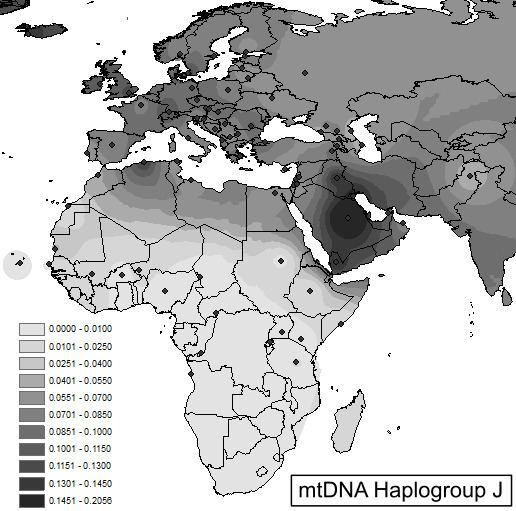Descendants J1, J2 | Ancestor JT | |
 | ||
Possible time of origin 45,000 years before present Defining mutations 295 489 10398 12612 13708 16069 | ||
Haplogroup J is a human mitochondrial DNA (mtDNA) haplogroup. The clade derives from the haplogroup JT, which also gave rise to Haplogroup T. In his popular book The Seven Daughters of Eve, Bryan Sykes named the originator of this mtDNA haplogroup Jasmine. Within the field of medical genetics, certain polymorphisms specific to haplogroup J have been associated with Leber's hereditary optic neuropathy.
Contents
Origin
Around 45,000 years before present, a mutation took place in the DNA of a woman who lived in the Near East or Caucasus. Further mutations occurred in the J line, which can be identified as J1a1 (27,000 yrs ago), J2a (19,000 yrs ago), J2b2 (16,000 years ago), J2b3 (5,800 yrs ago), etc. Haplogroup J (along with ‘T’) MtDNA J & T colonised Europe from the Near East in the late Paleolithic and Mesolithic.
*Typographical error from original source material as per time table describing the spread of populations given in the same study.
However, any statements concerning the geographic origin of this or any other haplogroup are highly speculative and considered by most population geneticists to be 'story telling' and outside the domain of science . Furthermore, inferring close associations between a haplogroup and a specific archaeological culture can be equally problematic.
Distribution
Basal haplogroup J* is found among the Socotri (9.2%).
Haplogroup J occurs in approximately 12% of native European populations.
The average frequency of haplogroup J as a whole is today highest in the Near East (12%), followed by Europe (11%), the Caucasus (8%) and Northeast Africa (6%). Of the two main sub-groups, J1 takes up four-fifths of the total and is spread widely on the continent while J2 is more localised around the Mediterranean, Greece, Italy/Sardinia and Spain.
There is also limited evidence that the subclade J1 has long been present in Central Asia. For instance, perhaps the highest incidence of haplogroup J is the 19% of Polish Roma, who belong to J1 (although this has also been ascribed to a "founder effect" of some kind). In Pakistan, where West Eurasian lineages occur at frequencies of up to 50% in some ethno-linguistic groups, the incidence of J1 averages around 5%, while J2 is very rare. However, J2 is found amongst 9% of the Kalash minority of north-west Pakistan.
In the Arabian peninsula, mtDNA haplogroup J is found among Saudis (10.5%-18.8% J1b) and Yemenis (0%-20% J1b). The J1b subclade also occurs in the Near East among Iraqis (7.1%) and Palestinians (4%).
In Africa, haplogroup J is concentrated in the northeast. It is found among Algerians (3.23%-14.52%), as well as Copts (10.3% J1a; 10.3% J2), Sudanese Fulani (10.7% J1b), Meseria (6.7% J1b), Arakien (5.9% J1b), Egyptians (5.9%), Mozabite Berbers (3.53%), Sudanese Hausa (2.9% J1b), Zenata Berbers (2.74%), Beja (2.1% J1b), and Reguibate Sahrawi (0.93%).
Within Europe, >2% frequency distribution of mtDNA J is as follows:
Tree
This phylogenetic tree of haplogroup J subclades is based on the paper by Mannis van Oven and Manfred Kayser Updated comprehensive phylogenetic tree of global human mitochondrial DNA variation and subsequent published research.
Genetic traits
It has been theorized that the uncoupling of oxidative phosphorylation related to SNPs which define mt-haplogroup J consequently produces higher body heat in the phenotype of mtDNA J individuals. This has been linked to selective pressure for the presence of the haplogroup in northern Europe, particularly Norway. Individuals from haplogroups Uk, J1c and J2 were found to be more susceptible to Leber's hereditary optic neuropathy because they have reduced oxidative phosphorylation capacity, which results in part from lower mtDNA levels. J mtDNA has also been associated with HIV infected individuals displaying accelerated progression to AIDS and death. The T150C mutation, which is exclusive to but not definitive of, the J2 subclade of Haplogroup J may be part of a likely nuclearly controlled general machinery regarding the remodeling & replication of mtDNA. Controlling a remodeling which could accelerate mtDNA replication thus compensating for oxidative damage in mtDNA as well as functional deterioration occurring with old age related to it. Haplogroup J was found to be a protective factor against ischemic cardiomyopathy. It was also found that Haplogroup J was a protective factor among osteoarthritis patients from Spain but not from UK, and this was hypothesized to be due to a different genetic composition (polymorphisms) of the Haplogroup J in both populations. A study involving patients of European and West Asian origin or descent showed that individuals classified as haplogroup J or K demonstrated a significant decrease in risk of Parkinson's disease versus individuals carrying the most common haplogroup, H.
